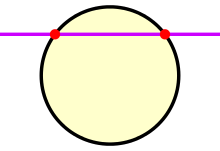Intersection
In mathematics, the intersection of two or more objects is another, usually "smaller" object. All objects are presumed to lie in a certain common space except in set theory, where the intersection of arbitrary sets is defined. The intersection is one of basic concepts of geometry. Intuitively, the intersection of two or more objects is a new object that lies in each of original objects. An intersection can have various geometric shapes, but a point is the most common in a plane geometry.
Definitions vary in different contexts: set theory formalizes the idea that a smaller object lies in a larger object with inclusion, and the intersection of sets is formed of elements that belong to all intersecting sets. It is always defined, but may be empty. Incidence geometry defines an intersection (usually, of flats) as an object of lower dimension that is incident to each of original objects. In this approach an intersection can be sometimes undefined, such as for parallel lines. In both cases the concept of intersection relies on logical conjunction.
Algebraic geometry defines intersections in its own way with the intersection theory.
Uniqueness
There can be more than one primitive object, such as points (pictured above) that form an intersection. It can be understood ambiguously: either the intersection is all of them (i.e. the intersection operation results in a set, possibly empty), or there are several intersection objects (possibly zero).
Examples in classical geometry
- Line–line intersection
- Line–plane intersection
- Line–sphere intersection
- Intersection of a polyhedron with a line
- Line segment intersection
- Intersection curve
Notation
Intersection is denoted by the U+2229 ∩ INTERSECTION from Unicode Mathematical Operators.
See also
- Constructive solid geometry, Boolean Intersection is one of the ways of combining 2D/3D shapes
- Meet (lattice theory)
References
Weisstein, Eric W. "Intersection". MathWorld.
